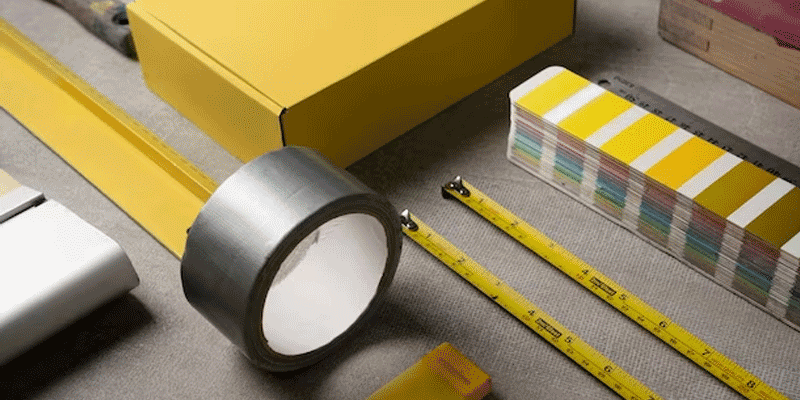When selecting a packaging tape for your shipping or storage operation, there are many things to consider.
The material, strength, thickness, breadth, degree of adhesion, and even convenience of usage of tapes might vary. Ignoring one or more of these considerations may lead to lost time, broken packages, improper storage of products, and even bodily injury if a box unexpectedly opens on or near someone.
This is a summary of the many types of packing tape, along with information on their characteristics and uses. Let us start by looking at the What Is Packing Tape Made Of.
Packing Tape
One common component of stationery is packing tape. This strong tape seals storage cartons, cardboard boxes, and shipments. It is sometimes called package or packing tape because of its flexibility and durability.
Another word often used, particularly in North America, is "scotch tape." But in actuality, 3M Corporation owns the brand name Scotch.
Although translucent or colored tapes are also available, parcel tape is typically brown in appearance. Because it is a pressure-sensitive product, its self-adhesive qualities become active once it is pushed into position.
The plastic polymers polyester and polypropylene, frequently abbreviated as polypro, make most packing tape.
Plastic or Paper
Paper and plastic materials are by far the most widely used and widely available packing tape on the market today. However, there may be other varieties as well.
Let's go over some of the main distinctions between them since each has advantages and disadvantages of its own:
Packaging Tape Made Of Plastic
Polyvinyl chloride, often called PVC tape, or the thermoplastic polymer polypropylene, sometimes known as polypro tape, are the two materials used to make plastic tape.
These polymers' broad color selection, robustness, dirt resistance, and affordable price point contribute to their popularity.
Although robust, the heat-activated or pressure-sensitive adhesive used in plastic packing tape can never provide precisely the same adhesive support as paper-based tape; however, more on this in a minute.
Compared to paper packaging tape, plastic tape is significantly more widely available, lightweight, affordable, and requires no special tools.
Furthermore, when combined with an automated or semi-automatic case sealer, plastic packing tape may significantly increase workflow speed and productivity since it is compatible with most high-speed case sealing systems.
As previously stated, the primary drawback of plastic tape is its lower adhesive strength compared to paper tape. This is not to suggest that paper tape is weaker than plastic tape; instead, tape sticks to the attached surface, but plastic tape may be torn off.
Plastic packing tape generally has acceptable (albeit not the greatest) adhesive strength and is widely available, cheap, and adaptable.
Tape for Packing Paper
Paper is the primary ingredient of paper tape, also known as gummed or water-activated tape. Because paper tape is 100% recyclable, it's the perfect option for people who care about the environment.
The water-activated adhesive used in paper tape necessitates using a gummed tape dispenser.
While activating the tape using a sponge or other wet substrate is feasible, doing so would be very time-consuming and significantly slow down your packing process.
Another advantage of dispensers is that they dispense tape in predetermined lengths, saving you from cutting it yourself.
This tape makes the package tamper-proof by creating a paper-to-paper connection with the case used to seal it. Removing the tape without causing damage to the box is complex, making it evident when there has been an effort at tampering.
As previously indicated, the link between the tape and the paper surface makes water-activated paper tape keep a better seal than plastic tape.
However, remember that you may only use this tape to seal paper boxes or other containers. For example, paper tape works best for filling plastic containers since it doesn't connect with non-paper materials.
Types of Packing Tape
There are several varieties of packaging tape, and each is appropriate for a particular application.
When choosing, please consider the intended usage, whether it will be done inside or outdoors, and the weight of the objects that must be transported or kept.
Additionally, some manufacturers sell customized package tape. Products may be promoted or company logos highlighted with custom color branding. Typically, suppliers provide a simple online purchasing platform where customers may rapidly input logos and images to create a unique parcel tape design. The following are a few of the main types of packing tape:
Packing Tape In Brown Color
By far, the most popular and well-known kind of package tape is brown. This multipurpose tape is perfect for bundling, sealing, and wrapping tasks requiring sturdy and dependable seals.
Transparent Package Tape
Put clear parcel tape and transparent plastic packing tape. This adaptable, all-purpose tape, which is often composed of polypropylene, has the benefit of providing a visibly discrete sealing.
Although the firm 3M also produces sticky tape in different colors, brown Scotch packing tape is frequently confused with clear tape under the brand name Scotch.
Printed Package Tape
Packaging tape comes in various colors from certain manufacturers, including white, pink, green, orange, and yellow. These are perfect for swiftly identifying certain pallets and shipments for processing or storage in factories, warehouses, and other business settings with simple color coding.
Does It Have Reinforcement Or Not?
Similar to plastic tape, paper-packing tape comes in two varieties, each with radically different adhesive strength. They are referred to as non-reinforced and reinforced, respectively.
Non-reinforced paper packing tape works well for shipments up to forty pounds and depends on the paper-to-paper bonding glue previously mentioned.
The paper-to-paper binding is the same as reinforced paper tape, but the tape is longer due to several fiberglass strands. This gives the tape more strength and makes it possible to seal any package weighing between forty and sixty pounds.
Using a Packing Tape Dispenser: A Guide
Packing tape may be manually applied by removing it off the roll and cutting it to the desired length, although it is prone to twisting and tangling.
CommonTape dispensers and guns prevent waste and guarantee a smooth stick.
Parcel tape dispensers are made of plastic cartridges with ends extended towards the cutting mechanism or serrated edge, where the rolls are stored until needed.
These are essential gadgets. To cut the tape to the desired length, users must pull the tape firmly forward and down.
Tape guns are another name for handheld tape dispensers. These operate on the same idea: more giant rolls of tape are clamped onto a rotating wheel such that the end of the tape is facing the blade. Users' broad, haptic pistol-grip handle of tp is where we apply tape directly to the target surface. The following details how to fill and operate a parcel tape gun:
- Make sure the tape is positioned correctly before attaching it to the wheel.
- The tape end should be extended to the cutting edge by firmly inserting it through a dispensing hole underneath the cutting mechanism. Verify that the tape is straight, hasn't twisted, and hasn't developed air bubbles.
- Use the pressure-adjusting handle on the gun, if it has one, to make sure the tape is tight and ready to use.
- Pull the tape along the surface after pressing it against the box or container.
- Slice the tape.
- Tape dispensing machines are used in automated packaging lines for professional usage in large volumes, often using special low-noise tape.
Conclusion
Items around the home may get sticky residue from packing tape. Apply any home oil—such as mineral, olive, or lemon oil—to a piece of strong-textured but non-abrasive fabric, such as terry cloth, and massage to remove this. Even oils with penetration, such as WD-40, will work.

















Add Comment